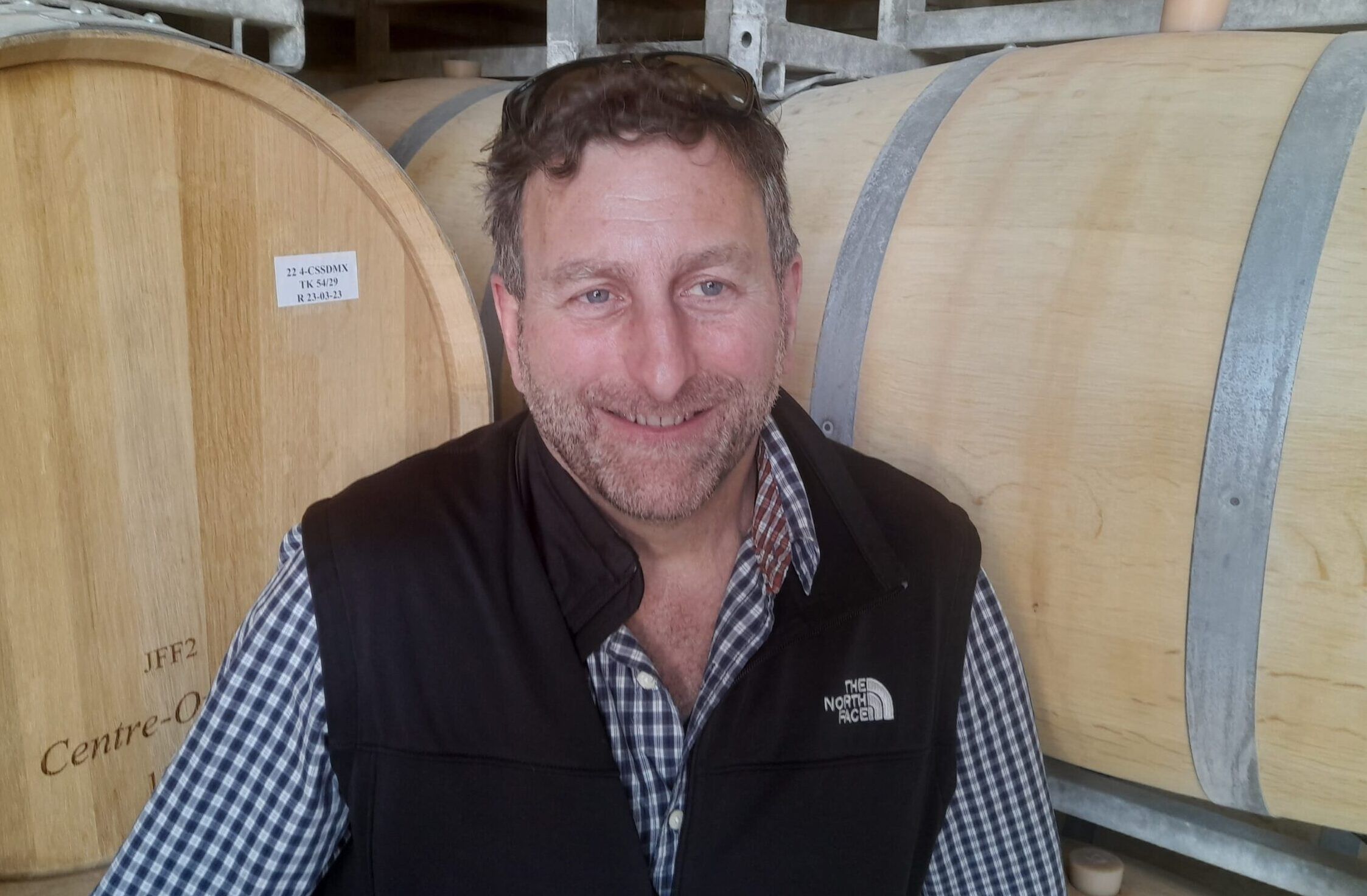“We can potentially sell on some bulk wine from the bleed and press, and bottle 500,000 for our own labels comfortably without compromising quality,” says Tenuta di Arceno winemaker Lawrence Cronin.
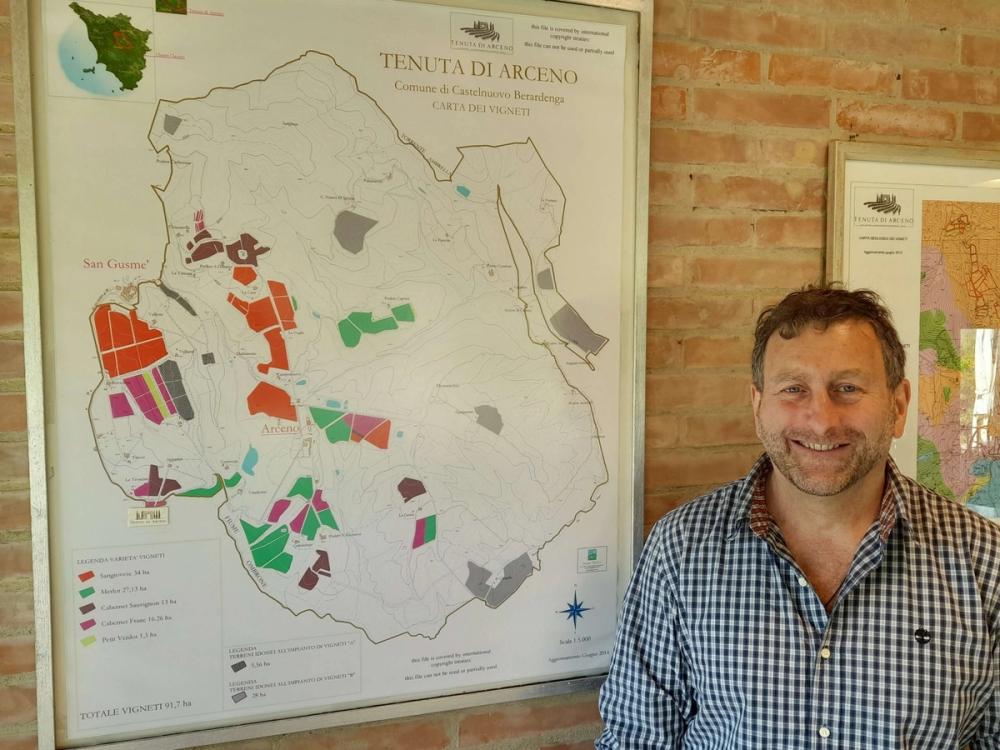
Man with a plan: Lawrence Cronin, Tenuta di Arceno, June 2023
When none other than Jancis Robinson MW OBE described Barbara Banke recently as ‘the most significant woman in wine,’ it is difficult not to take notice. For Banke, a former land lawyer, it is perhaps even more difficult not to shout it from the rooftops, but that is most certainly not her style. While delighted to receive such a compliment from the doyenne of wine critics, Banke just keeps on presiding shrewdly over her company Jackson Family Wines (JFW)’s 5,600 hectares of prime vineyards dotted around the world in eight countries, and letting her highly able vineyard managers and winemakers get on with producing dozens of top-class wines.
Banke (pronounced ‘Bankey’ on account of some Danish ancestry) turns 70 in August but takes a keen interest in all her 50-plus wine brands from her California home, while granting them the autonomy to manage themselves without undue interference. This is particularly the case with her Tuscan estate, Tenuta di Arceno, which she visits at least once a year, spending a week there after Royal Ascot where her own horses are frequently racing. Acquired in 1994 by her and her late husband, Jess Jackson, the winery has had the same viticulturist, Michele Pezzicoli, since the outset and the same winemaker, Lawrence Cronin, since the early millennium. Cronin works in conjunction with Pierre Seillan, the highly regarded French vigneron who is based at JFW’s Vérité estate in California but whose links with Tenuta di Arceno go back to its very establishment.
“People before profit,” is Banke’s mantra according to the CEO of JFW, Rick Tigner. This inspires loyalty in her staff. “She loves to walk around her estates,” Pepe Schib, the Tenuta di Arceno global brand ambassador, told me on a visit there in June. “She always goes walking early in the morning, and is not flashy, just totally down-to-earth. She pops up here, which is super nice. While casual on the outside, she gives you an exact idea how she wants things done. She wants the business run the right way but gives us the freedom to perform the right way.”
For Cronin, an American with some Sicilian ancestry and an Italian wife, a big expansion of the winery facility over the course of this summer is a welcome investment.
“We can currently produce up to 400,000 bottles per annum, but with the expansion, we’ll be able to double that if production warrants it,” he said. “We can potentially sell on some bulk wine from the bleed and press, and bottle 500,000 for our own labels comfortably without compromising quality. We’ll get a beautiful new barrel room, with more puncheons and some 27hl casks. We’ll have less moving of the wines, which we can leave in oak longer. Some space constrictions will go away.”

Tenuta di Arceno’s vineyards above San Gusme
Changes at the estate
The stunning 1,000-hectare estate, in the commune of Castelnuovo Berardenga, is an ancient one, situated between 300 and 500 metres above sea level in rolling hills some 20km from Siena. Native vegetation predominates along with 50 hectares of olive trees. Cronin vinifies grapes from about 105 hectares of vines, of which 18 are leased. Density is a uniform 5,000 vines per hectare. There are 92 hectares on the estate, with several being replanted each year.
About three-quarters of production is formed by three labels – Il Fauno, Chianti Classico and Chianti Classico Riserva. The former, the biggest-selling at around 130,000 bottles, is a Bordeaux blend. Then there are the super-premium wines: Strada al Sasso Gran Selezione, Campolupi Gran Selezione (both 95-100% Sangiovese), Valadorna (100% Merlot) and Arcanum (100% Cabernet Franc).
The decision to switch the latter pair from blends to single varietals was a carefully considered one. The 2018 Valadorna was the first vintage to be 100% Merlot (the 2017 having been 42% Merlot, 32% Cabernet Franc, and 4% each of Cabernet Sauvignon and Petit Verdot). Similarly, the 2017 Arcanum was the first to be 100% Cabernet Franc, having previously been 60-70% Cab Franc with the balance Merlot and Cabernet Sauvignon.
“We decided to go to 100% single varietals to keep the purity and expression of the three main grapes here,” Cronin said. “It was a desire to express the terroir and the soul of the estate through the different plots. What better way to express that than with a single varietal?”
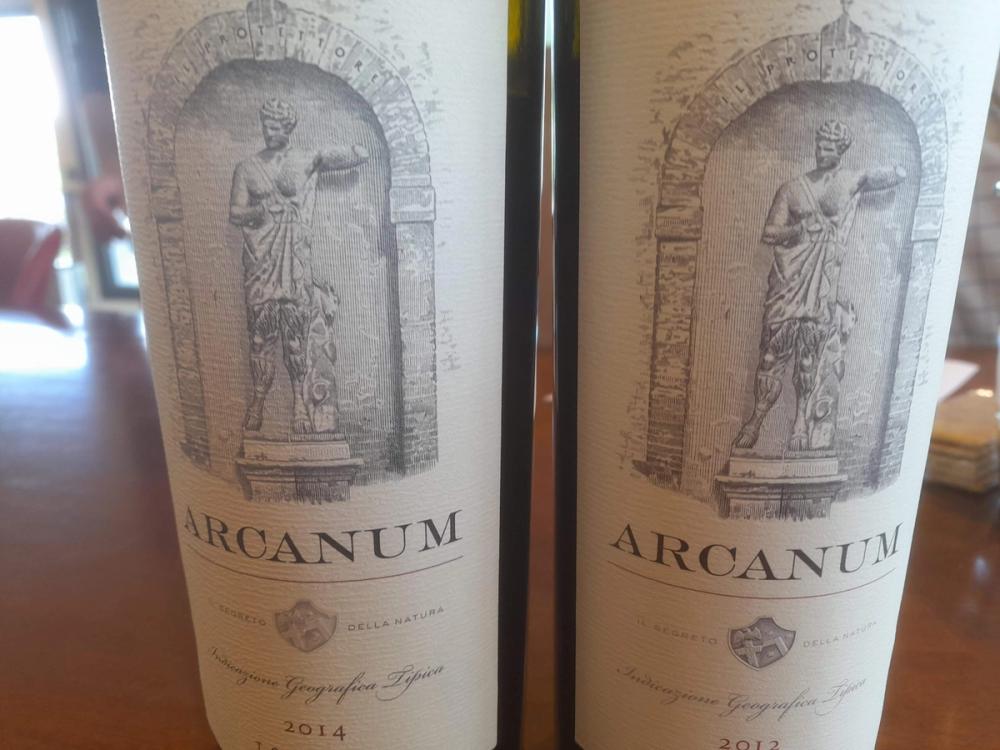
From the 2017 vintage Arcanum is made with 100% Cabernet Franc
The Valadorna is one of Banke’s favourite wines according to Cronin. Indeed, she named one of her horses after the label – a filly that won five races.
“The fruit comes from two blocks called the Valadorna vineyard and also from three other blocks in the Capraia vineyard higher up. So it’s a blend of micro-crus, which makes for real complexity. They ripen at different times, so I pick on at least four different days.”
As for the Cabernet Franc, Cronin has 12 blocks spread over 17 hectares to select from.
“When I first came here, we had only 1.2 hectares of Cab Franc,” Cronin recalled, “but with the increase, I can choose the best fruit. Annoyingly, we lose some to the wild boars and the deer, who both only eat the ripe grapes. The good thing with the Cab Franc is that it gets ripe not too early and not too late. Every year it’s probably the most consistent grape we have in terms of its relation to weather and harvesting, so it’s the highest quality every year because of when it gets ripe here. We keep the fruit and canopy in balance to avoid greenness, and ferment at a slightly lower temperature, 26°C, than the other reds as any green flavours can get greener at a higher temperature.”
The racing connection with the wines extends to the ‘Strada al Sasso’ label. It is the Italian translation of Stonestreet, the name of the Jackson family’s horse farm in Kentucky. When Jess Jackson died in 2010, the old label was changed to Strada al Sasso as a tribute to him, for Stonestreet was also his middle name. The wine is made from the best 35 to 40 barrels of ten clones of Sangiovese that come from the Strada al Sasso vineyard (formerly known as ‘La Porta’) just below the charming village of San Gusme, where Tenuta di Arceno owns a small hotel.
Viticultural concerns
Cronin’s winemaking philosophy marries well with Banke’s embrace of sustainability. Lowering carbon emissions in the wine industry is one of her laudable aims, and the driver for her and the Spanish Torres family’s joint creation of the International Wineries for Climate Action (IWCA) initiative in 2019. Daughter Julia is heavily involved in the sustainability movement, and is part of the JFW business along with fellow siblings, Christopher, whose wedding took place at Tenuta di Arceno, and Katie. Banke said in 2020 that she had “another five to ten years in me, and then I’ll leave it to the kids.”
While there are no plans to go for organic certification, Cronin professes he is a non-interventionist at heart. “I only try to intervene if there’s a big problem,” he mused. “It is what it is. I always have this fear of ruining the wine. The wine was where it was – the soul was there – I don’t want to mess with it.”
Quercetin is one issue Cronin sometimes has to deal with. “A problem with Sangiovese in this area is quercetin, a component of the skin that can cause precipitation later in the bottle. In 2014-15 in Brunello, they had a load of sediment from precipitation in the bottle even though it had been filtered. The more sun on the grapes the higher proportion of quercetin, which the sugar converts into a precipitate. Now people add PVPP to take it away. I have done but not every year.”
That apart, Cronin interferes as little as possible. He does no fining, and only light filtration with a pad filter (although the more expensive crossflow filtration is in the budget for next year). He aims for low free sulphur dioxide levels of 22 to 25 mg/l.
Even green harvesting is only performed in the event of ‘massive clusters’ as Cronin puts it.
“In the beginning, we were always green-harvesting, but now it’s just the end rows for sure. For most of our Merlot, we have irrigation. For a couple of years, we haven’t had to irrigate but for sandy soil vineyards we do. Our soils are made up predominantly of sand, with clay and loam too. People have this negative thing about irrigating but we’re just trying to keep the plant alive. In super hot years, our wells dry out – we have our little pond but no lakes.”
As far as oak is concerned, Cronin opts largely for a medium-light toast.
“Our company owns an estate in France where we choose our forests and bring the wood to a barrel-maker in Bordeaux,” he revealed. “We get 200-250 new barrels each year with toasting we choose. We can see what tree a barrel came from, so we have very good traceability. I use no new oak for any of our Sangiovese as it covers too much fruit; and one-year old exclusively for the Gran Selezione. Then 60-70% new oak for the top premium labels.”
Thanks to a wide diurnal range and favourable soil pH, acidity is not a problem.
“I have never ever added any acid,” Cronin declared. “One year, I even de-acidified – in 2014. I don’t even look at the acid during harvest any more, but pH is a big indicator for me where we are. Sangiovese can be 3.25-3.35 at harvest. After fermentation last year, Strada al Sasso finished at 3.3 (TA 6.4g/l) while Campolupi, which actually has a higher elevation, had a higher pH of 3.4 and lower TA of 6g/l. It doesn’t make any sense but it’s to do with pH of the soil – 7.2 for Campolupi and 6.8 for Strada al Sasso. The diurnal range is from 10°C at night, although usually 12-13°C, up to 35 or 40 degrees by day. But sometimes we get cooling breezes, especially if it’s a north wind.”
An elevated site at 650 metres near the estate was identified and leased when Cronin and Banke decided they wanted to produce some Chardonnay, which will be classified as Toscana. 1.3 hectares of vines were planted this spring, with Pezzicoli selecting the clone. “It should give us about 600 cases a year – basically between my wife and Barbara to drink,” Cronin quipped. “No, we’ll sell some in four years time, but Barbara wants 20 cases in the cellar for when she comes here.” A suitable holding for the most significant woman in wine.
So how were the Tenuta di Arceno wines tasting?
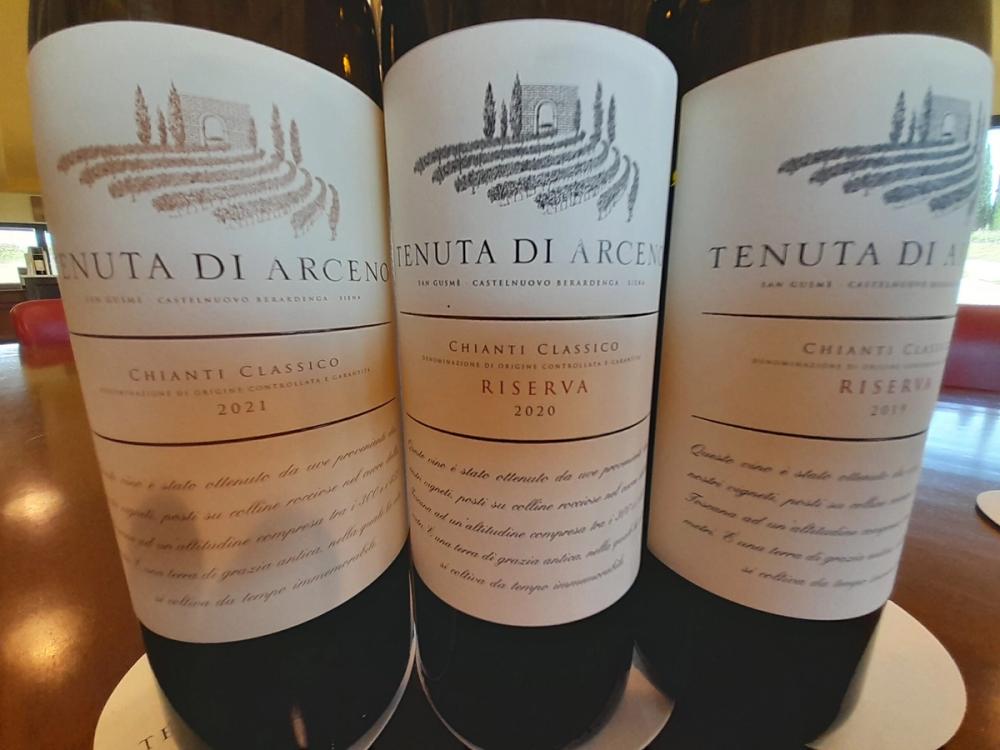
Tenuta di Arceno, Chianti Classico DOCG, 2021, 14.5% abv
85% Sangiovese, 15% Merlot. Enticing aromas of violet, blue flowers, forest floor and black pepper. Morello cherry notes with well-integrated tannins and fresh acidity. Begging to be drunk now.
Tenuta di Arceno, Chianti Classico Riserva DOCG, 2020, 14.5% abv
90% Sangiovese, 10% Cabernet Sauvignon. Herbal notes on nose with cranberry and a touch of orange peel. Racy acidity (pH3.35) with very attractive cherry fruit and strong tannins. A top-notch Chianti Classico Riserva from a classic year.
Tenuta di Arceno, Strada al Sasso Gran Selezione, 2020, 14.5% abv
100% Sangiovese. Just released (1 July, ’23). Powerful tannin structure with vibrant acidity. Low-yielding with fabulous concentration and length.
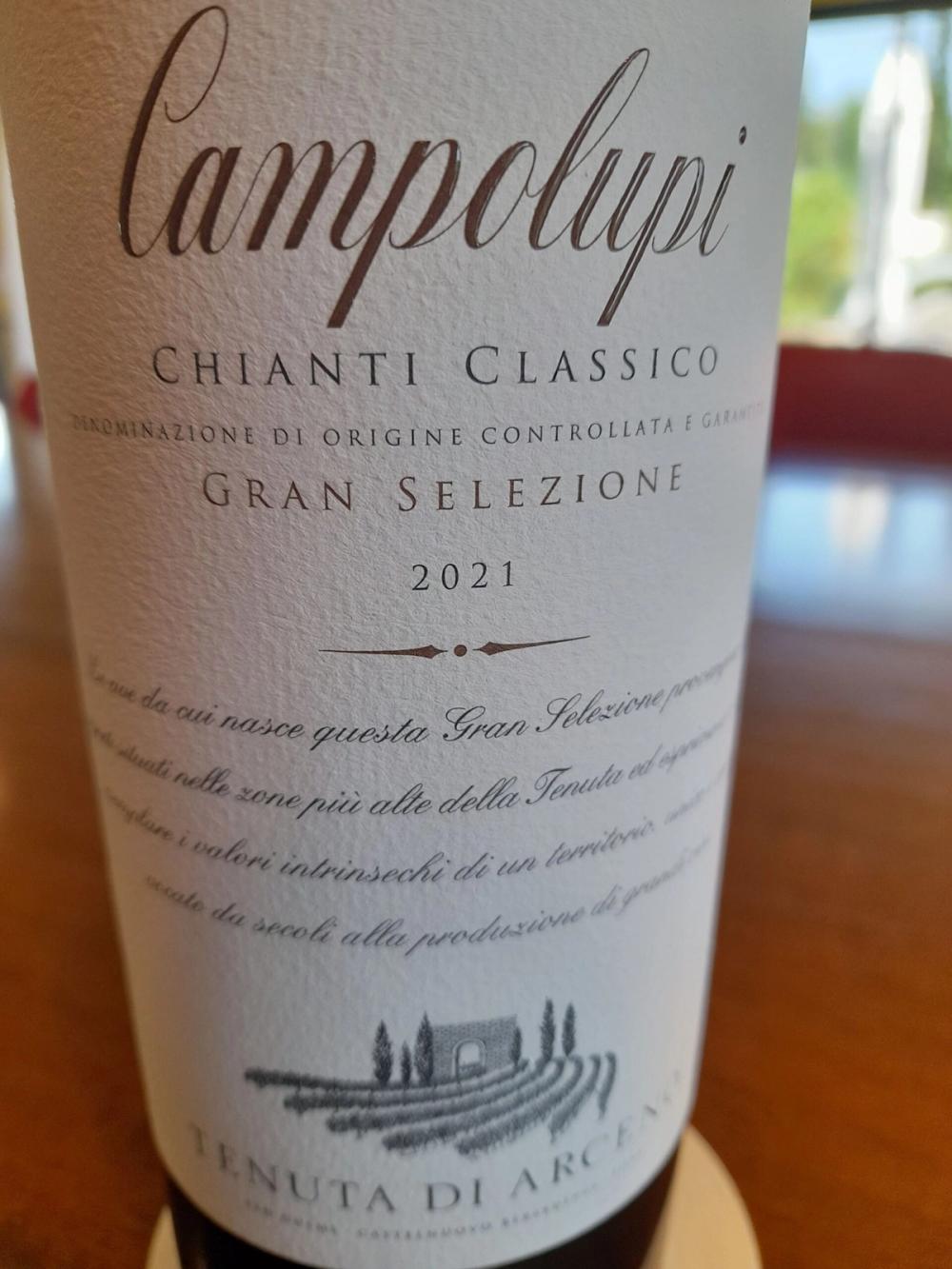
Tenuta di Arceno, Campolupi Gran Selezione 2021, 14.5% abv
95% Sangiovese & 5% Colorino (adding power and colour). Vibrant acidity (pH 3.4) with high quality if overt tannins. Generous red cherry fruit with earthy notes. Elevage in second-fill French oak. Only bottled in May ‘23, so needs time but will reward patience.
Tenuta di Arceno, Il Fauno, Toscana IGT 2020, 14.5% abv
41 % Merlot, 34 Cab Franc, 20 Cab Sauvignon, 5 Petit Verdot; 30% new oak. The faun statue on the estate inspired the label for this Bordeaux blend. Raspberry and strawberry aromas, with complex, concentrated black fruit on the palate. Chewy tannins with liquorice and tobacco on a long finish.
Tenuta di Arceno, Valadorna 2018, Toscana IGT, 14.5%
100% Merlot. A blend of different micro-crus helps give real complexity to this voluptuous wine, with its silky tannins. Structure from two-thirds new French oak, with glorious, intense plummy red fruit. Very long.
Tenuta di Arceno, Arcanum, Toscana IGT 2017, 14.5% abv
100% Cabernet Franc, 70% new French oak for 12 months. Aromas of oregano and mint, with a core of blueberries, dark chocolate and caramel. Dusty tannins and fresh acidity with richness and multiple layers of complexity. A magnificent wine with a lengthy life ahead of it.
The wines of Tenuta di Arceno are imported into the UK by Fells and OenoFuture
